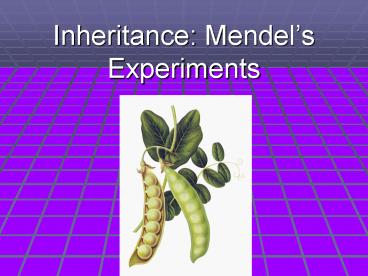Inheritance: Mendel PowerPoint PPT Presentation
1 / 29
Title: Inheritance: Mendel
1
Inheritance Mendels Experiments
2
Ideas on Inheritance Before Mendel
- Pangenesis
- Particles in the body are transmitted to the
reproductive cells - Blending
- Black horse X White horse Gray horse
- Homunculus (small human)
- Spermists believed a small fully formed human was
inside the sperm and the female contributed
nothing but her womb!
3
Gregor Mendel(1822-1884)
- Augustinian monk
- Studied the inheritance of traits in over 20,000
pea plants - Kept meticulous notes on his data
- No knowledge of DNA or chromosomes
- Father of genetics
- His genius was not recognized until after his
death
4
The Lingo of a Geneticist
- Gene
- The unit of heredity (ex. Gene for flower color)
- Alleles
- Alternate forms of a gene (ex. Purple or white
flower color) - Dominant vs. Recessive
- One allelic form masks the presence of another
- ex. Purple flowers are dominant over white
flowers (white is recessive) - Dominant capital letters
- Recessive lower case letters
- Pn and Fn
- Parental and Filial generations
5
More Lingo
- Genotype vs. Phenotype
- Genotype is what alleles an individual has (ex.
One purple flower allele and one white flower
allele) - Phenotype is what the individual looks like (ex.
Purple flowers) - Homozygous vs. Heterozygous
- Homo same
- Hetero different
- True-breeding
- Phenotype of parent is always seen in offspring
- The phenotype counterpart to the genotype term
homozygous - If an individual has a homozygous genotype, it
will be true breeding - Monohybrid vs. Dihybrid
- A monohybrid cross looks at just one trait in
parents who are hybrids - A dihybrid cross looks at more than one trait in
parents who are hybrids - Hybrid is another way of saying heterozygous
6
Monofactorial Inheritance
- A.k.a. Mendelian traits
- Inheritance of a trait is determined by one gene
- Does not really exist
- Virtually all traits are affected to some degree
by other genes and by environmental factors
7
Pea Plant Traits
8
Mendels Experiments(Pea Sex)
9
The Gene for Stem Length
- The tall allele is dominant (T)
- A true-breeding tall plant is homozygous dominant
(TT) - The short allele is recessive (t)
- A true-breeding short plant is homozygous
recessive (tt)
10
Homozygous (True-breeding) Dominant
- Tall plant X Tall plant
X
All offspring will be tall
11
Homozygous (True-breeding) Recessive
- Short stem plant X Short stem plant
X
All offspring will be short
12
Non-True-Breeding
?
- Tall plant X Tall plant
X
Some offspring are tall Some offspring are short
13
Monohybrid Cross Stem Length
Parental generation (P1) Tall X Short (Both
true-breeding) F1 All Tall (Non-true-breeding)
a.k.a. hybrids F2 ¼ Short ¾ Tall
True-breeding Tall
True-breeding Short
Non-true-breeding Tall
14
Monohybrid Cross -Flower Color
15
Mendels Law of Segregation
- Elementen separate into gametes
- We now know elementen as genes
- Each individual carries 2 alleles for every gene
- One on each chromosome
- One allele on the chromosome from mom and one
allele on the chromosome from dad - Possibilities for any given gene
- Homozygous Dominant (AA) (True breeding)
- Heterozygous (Aa) (Non-true-breeding)
- Homozygous Recessive (aa) (True-breeding)
- Gametes carry just ONE allele for each gene
- Possibilities are A or a
16
Our Old Friend Meiosis
Germline Cells
17
Phenotypic ratio
The genotypic ratio is 121
18
The Punnett Square
- Used to determine phenotypic and genotypic ratios
- Represents possible alleles in gametes and how
gametes may combine
Probability of having an offspring with tt is
the same (1/4) for every pregnancy/fertilization.
s are ratios, not of offspring
19
Example
- True-breeding (homozygous) dominant
20
Dominant and Recessive Traits
- A dominant trait requires only one allele in
order for the dominant trait to be expressed
- There MUST be 2 recessive alleles present in
order for a recessive trait to be expressed
(phenotype)
21
Examples
- Ex. 1 True-breeding (homozygous) recessive
- Ex. 2 Homozygous dominant X heterozygous
- Ex. 3 Monohybrid (heterozygous) cross
22
Genotype vs. PhenotypeThe Test Cross
23
Example
- Unknown X Homozygous Recessive
- a.k.a the test cross
24
Autosomes vs. Sex Chromosomes
- Autosomal traits are found on non-sex chromosomes
so (they are not found on the X or Y sex
chromosomes)
25
Modes of Inheritance
- Autosomal dominant inheritance
- If a child exhibits the trait (phenotype) at
least one of the parents also exhibits the trait
(phenotype) - Autosomal recessive inheritance
- Heterozygotes are carriers (genotype) and do not
exhibit the trait (phenotype)
26
Autosomal Dominant
27
Autosomal RecessiveStraight Hair as an Example
28
Autosomal RecessivePhenylketonuria as an Example
29
Mendels Conclusions
- There are discrete units of inheritance
(elementen) - We now call these genes
- Offspring inherit a unit (gene) for each trait
from each parent - Different units (genes) assemble independently in
the gametes

